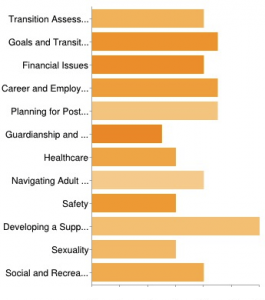Thanks for participating in the Planning for Life After IEPs parent survey!
I’m already using the data to plan posts.
As promised, the anonymous data has also been shared with Special Education Advisor, Our Special Families Village, and IEP for Mom. The great folks at these sites, who collaborated with me to promote the survey, care about your priorities. The survey data will inform their planning.
Curious about the results? Here are some highlights.
Topics
As you can see from the graph, there’s significant interest in all of the topic areas.
Developing a support network is the area of greatest interest. This shows real insight on your part. Young adults who love life after IEPs have intentionally developed personal networks. How do they (and their families) do it? Check out the brand new Growing Personal Networks section of our Free Transition Tools Shop for resources. We’ll keep adding new tools over time.
Turns out there are exactly as many families interested in planning for careers and employment as there are families interested in planning for postsecondary education and training. We’ll offer a balance of resources in both areas - as well as addressing the ‘whole person” needs of youth in areas like finances, health, and recreation.
There’s significant interest in the topics of transition assessment and transition planning related to IEP goals and specially designed instruction. I’m planning posts to address these topics later this summer.
Ages and skills
Parents of tweens responded to the survey in force (23%). And almost half of respondents are parents of youth under 15 years old. I’m delighted to see families getting an early start on planning for life after IEPs.
About 20% of the respondents are parents of 18-21 year old youth, and parents of 15-17 year olds comprised almost 15% of survey respondents.
There was a broad diversity in terms of the skill strengths and needs of kids.
Obviously, our transition planning priorities shift at different ages, and our child’s skill strengths and needs factor large when it comes to planning for the future. When I tackle transition topics on the site, I’ll do my best to make the connection to skills and key steps at various ages.
Format preferences
The majority of you prefer to receive information in print - through posts and e-books. But a significant minority is interested in video and webinar presentations. I’ll see if I can learn some new skills to accommodate your preference.
Customized coaching?
Almost 70% of you are or may be interested in customized coaching to help you develop transition action plans that meet your child’s specific needs and interests.
I’ve been getting emails saying that, although the information on the site is helpful, it can feel overwhelming to sort through what applies to your child’s particular circumstances. I am now considering the idea of offering customized coaching on a limited basis.
Moving on from here
By taking the survey, you’ve given me a lot to think about. Your input is helping me plan the direction of the site to better meet your needs.
And remember, I love hearing from you in the comments and via email.
Stay in touch, ok?
And enjoy the journey - one day at a time!




{ 2 comments… read them below or add one }
Hi
These issues are all addressed in many life skills curriculums.
The problem is districts want special education teachers to use
the same curricula as is used by general education-even when
District and State goals are correlated with those of the life skills curriculum.
What’s more important…preparing a child with severe disabilities for life or making sure he gets biology, civics, geometry credits when he doesn’t understand one iota of what’s being taught?
Thanks for your comment, Linda! The dynamic you describe, while not uncommon, must be viewed in context. I’m sure you’re familiar with the IDEA provisions below, but I feel its important to state them here for common reference.
First - IDEA explicitly states its purpose is:
(1A)” to ensure that all children with disabilities have available to them a free appropriate public education that emphasizes special education and related services designed to meet their unique needs and prepare them for further education, employment and independent living.”
Indicator 13 states that the IEP must be an individualized plan that “reasonably prepares” the student for his/her postsecondary goals.
The IEP team must consider how the students’s present academic and functional skills relate to those needed for the student’s postsecondary goal(s).
The team then develops an individualized plan to “reasonably prepare” the student for the postsecondary goal. This can involve instruction in the school building (general education or special education classes) - as well as community based instruction. The key is to address the skills the IEP team agrees are needed to “reasonably prepare” the student for postsecondary education - and then teach those skills in the least restrict environment as determined by the whole team.
It’s important that parents and students have access to the information and resources they need to collaborate with the school as be fully participating members of the IEP process.